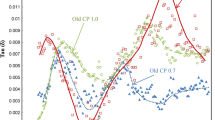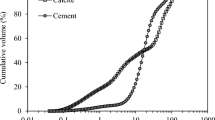Abstract
Microindentation creep and dynamic mechanical thermo-analysis measurements were carried out on compacted specimens of cement paste prepared at water/cement ratios of 1.00, 0.50 and 0.40 and hydrated for 45 years. Similar data was obtained for pastes prepared at w/c = 0.40 and hydrated only 2 months. Creep modulus–mass-loss curves were plotted for all the systems studied. These curves were used to emphasize salient differences between all the paste systems. The influence of degree of hydration, volume concentration of C–S–H, capillary porosity, C–S–H chain-length and the restraining effect of the unhydrated cement particles on creep are parameters that are used to provide a possible explanation for the observation that the creep of the old pastes is higher than creep of the young pastes. The structural role of water in the creep process at various stages of equilibrium drying from the 11 % RH condition is discussed.





Similar content being viewed by others
References
Nasser KW, Neville AM (1967) Creep of old concrete at normal and elevated temperatures. ACI J 64:97–103
Wittmann FH (1982) Creep and shrinkage mechanisms. In: Bazant ZP, Wittmann FH (eds) Chapter 6 in creep and shrinkage in concrete structures. Wiley, New York, pp 129–162
Feldman RF (1972) Mechanism of creep of hydrated Portland cement paste. Cem Concr Res 2(5):521–540
Alizadeh R, Beaudoin JJ, Raki L (2010) Viscoelastic nature of calcium silicate hydrate. Cem Concr Compos 32:369–376
Meyers BL, Slate FO (1970) Creep and creep recovery of plain concrete as influenced by moisture conditions and associated variables. Mag Concr Res 22(70):37–41
Ruetz W (1968) A hypothesis for the creep of hardened cement paste and the influence of simultaneous shrinkage. In: Proceedings of the international conference on the structure of concrete. Cement and Concrete Association, London, pp 365–387
Hannant DJ (1968) The mechanism of creep in concrete. Mater Struct 1:403–410
Ali I, Kesler CE (1964) Mechanisms of creep, symposium on creep of concrete, ACI Special Publication No. 9, pp 35–63
Cilosani ZN (1964) On the probable mechanism of the creep of concrete. Beton I Zhelezobeton 2:75–78
L’Hermite RG (1960) Volume changes of concrete. In: Proceedings of the fourth international symposium on the chemistry of cement, vol II. Washington D.C., pp 659–694
Feldman RF, Beaudoin JJ (1983) Effect of applied stress on the helium inflow characteristics of hydrated Portland cement. Cem Concr Res 13(4):470–476
Vandamme M, Ulm F-J (2009) Nanogranular origin of creep. Proc Natl Acad Sci USA 106(26):10552–10557
Radjy F (1968) A thermodynamic study of the system hardened cement paste and water and its dynamic mechanical response as a function of temperature, PhD Thesis, Stanford University, p 349
Pourbeik P, Beaudoin JJ, Alizadeh R, Raki L (2014) Dynamical mechanical thermo- analysis of layered calcium silicate hydrates. J Therm Anal Calorim 118(1):1–14
Sellevold EJ (1976) Low frequency internal friction and short-time creep of hardened cement paste: an experimental correlation, hydraulic cement pastes: their structure and properties. In: Proceedings of a conference, University of Sheffield, Cement and Concrete Association, pp 330–337
Sellevold EJ, Richards CW (1972) Short-time creep transition for hardened cement paste. J Am Ceram Soc 55(6):284–289
Alizadeh R (2009) Nanostructure and engineering properties of basic and modified calcium-silicate-hydrate systems, PhD thesis, University of Ottawa, p 231
Soroka I, Sereda PJ (1968) The structure of cement-stone and the use of compacts as structural models. In: Proceedings of the fifth international symposium on the chemistry of cement, vol 3. Tokyo, pp 67–73
Feldman RF (1972) Factors affecting the Young’s modulus-porosity relation of hydrated Portland cement compacts. Cem Concr Res 2(4):375–386
Sereda PJ, Feldman RF (1963) Compacts of powdered material as porous bodies for use in sorption studies. J Appl Chem 13:150–158
Beaudoin JJ (1983) Comparison of mechanical properties of compacted calcium hydroxide and Portland cement paste systems. Cem Concr Res 13:319–324
Sereda PJ, Feldman RF, Swenson EG (1966) Effect of sorbed water on some mechanical properties of hydrated Portland cement pastes and compacts. Highw Res Board Spec Rep 90:58–73
Vandamme M (2008) The nanogranular origin of concrete creep: a nanoindentation investigation of microstructure and fundamental properties of calcium-silicate-hydrates, PhD thesis, MIT, p 366
Oliver WC, Pharr GM (1992) An improved technique for determining hardness and elastic modulus using load and displacement sensing indentation experiments. J Mater Res 7:1564–1583
Nguyen D-T, Alizadeh R, Beaudoin JJ, Pourbeik P, Raki L (2014) Microindentation creep of monophasic calcium-silicate-hydrates. Cem Concr Compos 48:118–126
Menard KP (1999) Dynamic mechanical analysis-a practical introduction. CRC Press LLC, Boca Raton, p 208
Nguyen D-T, Beaudoin JJ, Alizadeh R, Raki L (2014) Creep of calcium- silicate-hydrates: a particle sliding mechanism, submitted to materials and structures. See also Nguyen D-T (2014) Microindentation creep of calcium-silicate-hydrate and secondary hydrated cement systems, M.A.Sc. Thesis, University of Ottawa, p 142
Feldman RF (1971) The flow of helium into the interlayer spaces of hydrated Portland cement paste. Cem Concr Res 1(3):285–300
Nguyen D-T, Alizadeh R, Beaudoin JJ, Raki L (2014) Assessment of the structural role of water on the creep of C-S-H, submitted to Advances in Cement Research, 2014
Pourbeik P, Alizadeh R, Beaudoin JJ, Nguyen D-T, Raki L (2013) Microindentation creep of 45 year old hydrated Portland cement paste. Adv Cem Res 25(5):301–306
Author information
Authors and Affiliations
Corresponding author
Rights and permissions
About this article
Cite this article
Pourbeik, P., Beaudoin, J.J., Alizadeh, R. et al. Creep of 45 year old cement paste: the role of structural water. Mater Struct 49, 739–750 (2016). https://doi.org/10.1617/s11527-015-0534-5
Received:
Accepted:
Published:
Issue Date:
DOI: https://doi.org/10.1617/s11527-015-0534-5




